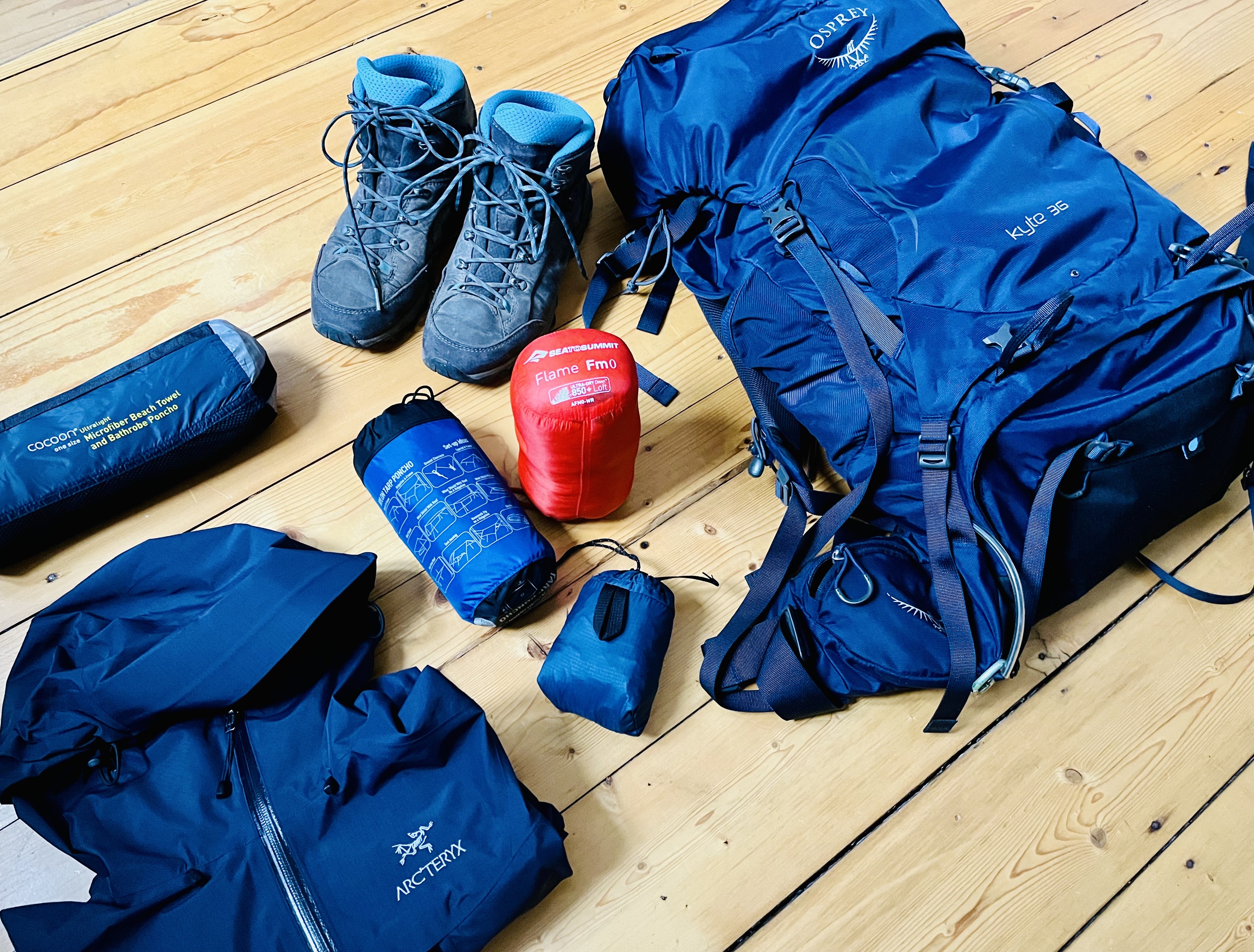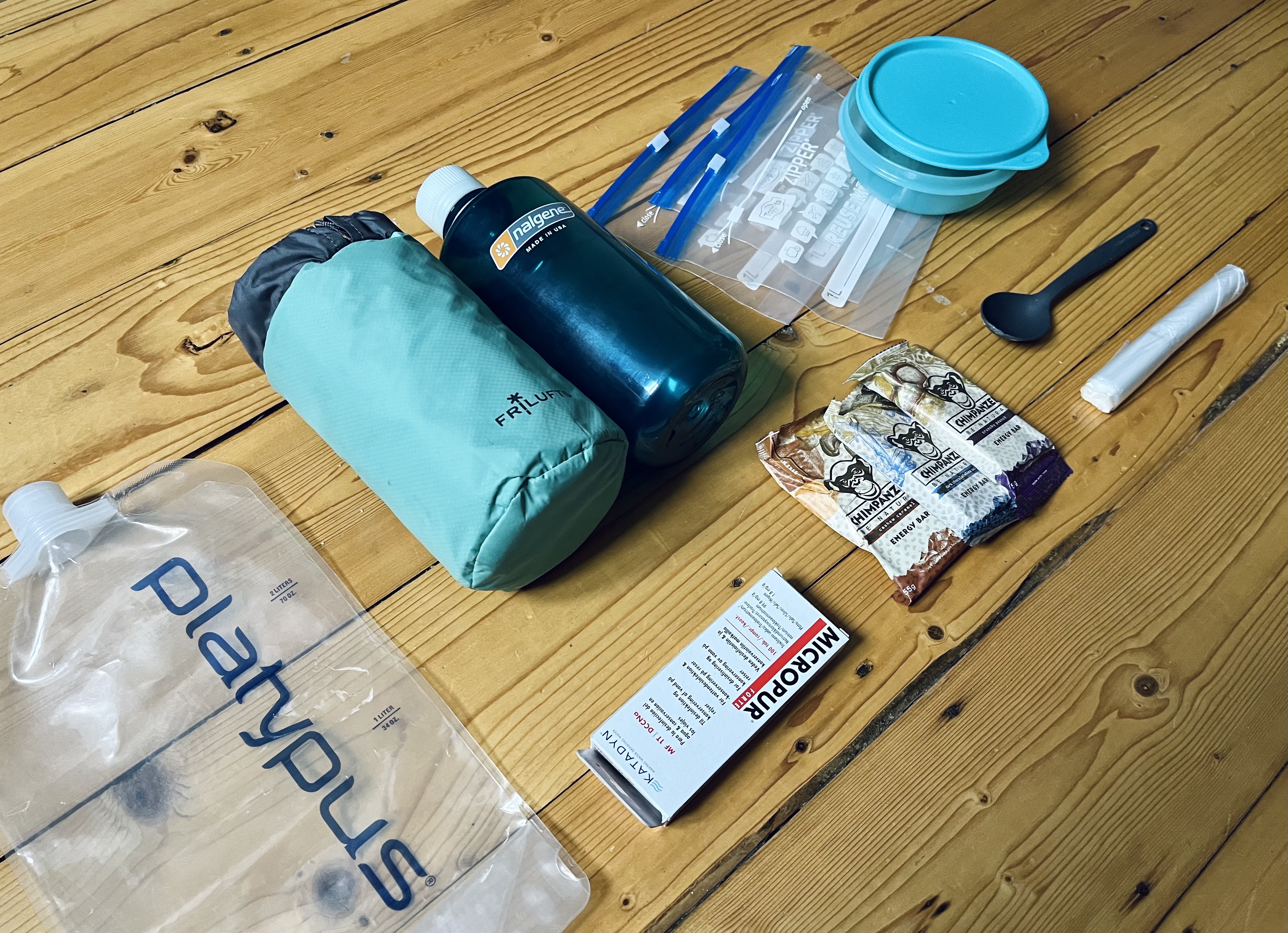Deciding on which clothes to pack for a long-distance hiking trail is easily one of the hardest categories to assemble. Especially when expecting a wide range of changing weather conditions, it’s a hard call to make if you want to take that extra fleece or not. A long-distance trail adds the constraint of wanting to pack as little weight as possible.
Luckily, many others have faced this challenge before you and there’s a heavily tested and approved solution: layering!
In this post, I’ll go into detail on what layering means and why it’s helpful when hiking in changing weather conditions. I also share my complete packing list of clothing I took when hiking the Alpe Adria Trail in spring. This is an excellent base for you to put together your own clothing packing list.
Also, check out my complete packing guide for the Alpe Adria Trail to see all the other equipment I took on my thru-hike.
What is layering? And why is everyone so excited about it?
Layering simply means putting on different layers of clothing on top of each other. It’s the key tool to be prepared for as many different weather conditions as possible without adding too much weight to your backpack. There are many different ways in which you can layer your clothes on a hiking adventure. One of the core set-ups is:
- Base layer. This is the set of clothes you wear directly on your skin (but not your underwear). It should be made of a material that’s breathable, meaning it supports good air and fluid flow. This allows you to exercise without heat building up or your clothes soaking up all the sweat. At the same time, this layer protects you from losing too much body heat in very cold climates.
- Second layer. This would normally be your “regular” hiking outfit. A pair of hiking pants and a long-sleeve shirt or t-shirt. It’s the core of your outfit. If it’s cold, you combine it with a base layer. If it’s very cold you add a third layer, too. If it’s changing between warm and chilly (cloudy day) you add a third layer that you can easily take off, e.g. a fleece jacket. If it’s warm and windy you just add a windbreaker… and so on. You get the gist.
- Third layer. For this, I’d recommend a lightweight fleece jacket. It’s much easier to regulate temperature while wearing it, in comparison to a jumper. It can also be combined with any of the other layers for maximum flexibility. A fleece jacket and a hard-shell rain jacket make a perfect combination for cold, rainy days. At the same time, you can wear a t-shirt on a warm day and just throw on your fleece if it gets a little chilly.
- Outer layer. This layer is meant as protection against weather forces like wind or rain. It can be a hard-shell rain jacket + trousers or a poncho. Ideally, your rain jacket is also wind-resistant, so that it can functions as a windbreaker, too.
In addition to all of these, you can add a variety of tube scarves, headbands, gloves, hats, etc., depending on your needs for each specific outdoor adventure.
To make this a bit more tangible, here’s a list of what I packed when hiking the Alpe Adria trail in spring. I was faced with a variety of temperatures, from snowy glaciers in Austria with temperatures dropping below 0°C at night to sizzling hot summer days of 30°C+ on the Adria coast in Italy.
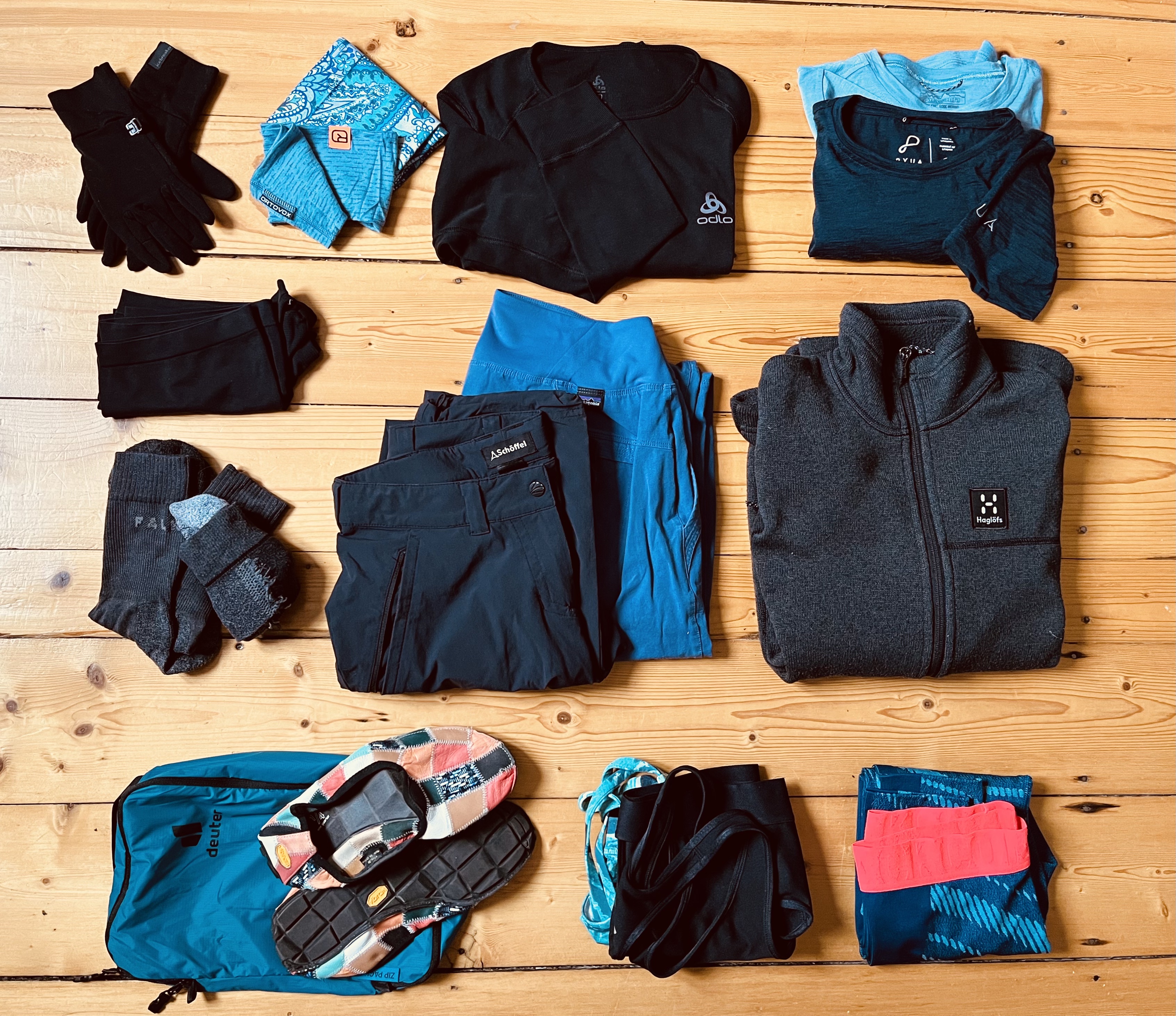
My Clothing Packing List for the Alpe Adria Trail
- 2 t-shirts
- 2 long-sleeve shirts
- 1 pair of hiking pants
- 1 pair of leisure pants
- 1 (warm) fleece
- 1 pair of long underwear
- 3 panties & 2 sports bras
- 2 pairs of hiking socks
- 1 tube scarf & 1 pair of gloves
- Some optional items
- additional shoes
- swimwear
- 1 pair of shorts
T-shirts And Long-Sleeve Shirts
I packed one merino wool t-shirt and one „regular“ sports t-shirt. While there are advantages and disadvantages for both, next time, I‘ll definitely just pack merino wool shirts. Any other fabric will just get smelly way faster and it‘s hard to get the smell out by only handwashing, even if you do so every day. The advantage those shirts have over merino wool is that they dry a lot quicker. However, it never happened that my merino shirt didn‘t dry overnight when I washed it in the evening. Also, I realized, I don‘t wear t-shirts during a hike, because long sleeve shirts offer much better protection against the sun, insects, and shrubbery, which I encountered nearly every day. I can highly recommend Icebreaker for merino wool long-sleeve shirts. They are absolutely amazing. I wasn‘t expecting this, but I ended up wearing my long sleeve shirt every single day. After the hike, I‘d hand-wash it and change into my t-shirt. And that‘s it. That‘s all you need really. Sometimes I did feel it would have been nice to have another option to change into but believe me, it‘s worth so much more to have a lighter backpack.
Hiking And Leisure Pants
Hiking pants are another crucial piece of equipment. Who’d have thought, but your legs move a lot when you’re hiking. So, it’s important to find pants that fit you well, don’t rub against your skin, and give you enough flexibility to move. Something that’s easily overseen is the right fit for your waste. When you try on hiking pants you normally don’t wear a 10kg backpack with a hip strap. You will, though, when you’re hiking a long-distance trail. So keep that in mind and look for pants that don’t extend past your hip bones. I personally only wear Schoeffel hiking pants. I‘ve tried several different brands, but have found that Schoeffel makes the absolute best ones. For one, the material is great. It‘s super comfortable, offers great ventilation, dries off quickly, and gives some protection from wind & sun. Also, they are one of the few brands that offer a short version, which is amazing for us hobbit folk. 🙃 What I found especially great about my Shoeffel Engadin is that they also have a built-in belt, which didn’t hurt with my backpack’s hip strap on. I didn‘t think I needed it as they fit me well but it turned out that after a few weeks Ion the trail, this belt was a lifesaver.
I also packed a pair of “leisure pants”. My idea here was to have some evening pants which didn’t look too much like hiking but that I could still use for hiking if need be (e.g. if my actual hiking trousers ripped). However, this plan didn‘t work out. Although I do like the pair of Patagonia climbing trousers I picked, they are not perfect for backpacking as they have a seam right on top of the hip bone where the hip belt of the backpack sits (didn’t listen to my own advice above here). Which is really weird, because that’s where a climbing belt would also sit, wouldn’t it? Anyhow, they really are only suitable for the evenings and this isn’t what you want on a long-distance hike. Also, they were comparably heavy. So, I‘d rather recommend getting a second pair of hiking trousers to wear in the evenings.
(Warm) Fleece
You definitely need some sort of fleece jacket. This is not only great for colder hikes but also in the evenings to throw over a t-shirt or to snuggle up after a good hot shower. I love my Haglöfs jacket. It’s a super nice, cozy, warm jacket, which I wore nearly every day. Sometimes during my hikes as a second or third layer, and sometimes in the evenings. The only disadvantage it has is that it’s comparably heavy. If I had the extra money, I might invest in an even more lightweight one for the future, but that‘s not on my immediate wish list.
Long Underwear Base Layer
I would definitely pack some long underwear as a base layer, especially if you‘re hiking in early spring or late autumn. They are gold for those frosty early mornings when you get up at 4 am to watch the sun rise over the mountaintops. Also, I often slept in them, if the night was really cold or the blankets were not too warm (especially if you don‘t bring a sleeping bag/liner). I‘d go for skiing underwear made from merino wool. I used a set of Odlo’s natural merino base layer, similar to this one, which worked out very well for me.
Panties And Sports Bras
3 panties and 2 sports bras, that‘s all you need really. It’s basically the same routine every day. After showering, you switch into a new set of underwear and wash out the one you were wearing during the day along with your other clothes. You could probably make it with just 2 panties as well, but I prefer having an extra one. I just think it’s extremely valuable in case you do need it and it really doesn’t add too much weight. For men, it’d be the same routine, minus the sports bra - unless you like wearing one of course. The same is true for women, of course, I know quite a few women from my hiking circles who don’t wear sports bras or use a shirt that has a sports braw sewn in already. If this is your preference, that can also be a handy way to save some weight on the go.
Hiking Socks
Socks actually need to be included in the essential gear part. Because they are just such a key piece of equipment! Make sure to get good, high-quality socks that fit you well. If you don‘t, you‘ll get blisters for sure. No matter how good your shoes are. And that’s no fun at all, no one wants that. Surprisingly, just like your shoes, socks also need breaking in (I didn’t know that before). That’s why you should wear a new pair of socks on a couple of shorter hikes before any long-distance trail. Also, bear with me here, don‘t wash them. Especially not before you set out on the trail. Rather wear them once before and then pack them. I know, I know, most of us don‘t want to hear this but talk to any experienced thru-hiker and you‘ll hear that this is one of the best ways to not get blisters. If you get high-quality socks with a large percentage of merino wool, they won‘t smell too bad too quickly anyways. Merino wool has the magic property of being antibacterial due to the lanolin in it (that’s what sheep use to protect themselves from bacteria). Every time, you wash merino clothes with detergent, however, some of it gets washed off and its magical properties will fade. Also, the detergent you use could cause blisters, too. So hang in there as long as you can, maybe only wash them every 4 days or once a week.
Tube scarf, gloves, etc.
A tube scarf is a secret weapon you should definitely bring along. You can wear it as a headband, on your wrist to wipe off sweat, as a scarf, or use it to clean your glasses. It could even be used as a bandage in an emergency. Definitely pack one. I‘d even recommend two. I was desperately wishing I had packed two when taking off at 3.45 am to see the sunrise at Kamplnock. And I actually found a second one only 2 hours later on the road. A bit spooky, I know, but I decided to rather think it was the universe at work, helping me out a little. 🤷♀️
If you’re hiking in the colder season of the year, late fall to early spring, I’d also recommend taking a pair of gloves. Especially when using hiking poles, they can be super valuable on those cold, windy days hiking along a mountain saddle without any shelter from the biting wind on your hands. I took a pair of thin merino wool gloves from Icebreaker and they were absolutely amazing. They are actually meant to be worn inside a pair of skiing gloves for extra warmth, but I found them ideal for my purpose of some protection on cold, windy days.
And that’s it. All of this, minus my day’s outfit, would fit into my small 3L packing cube from Deuter.
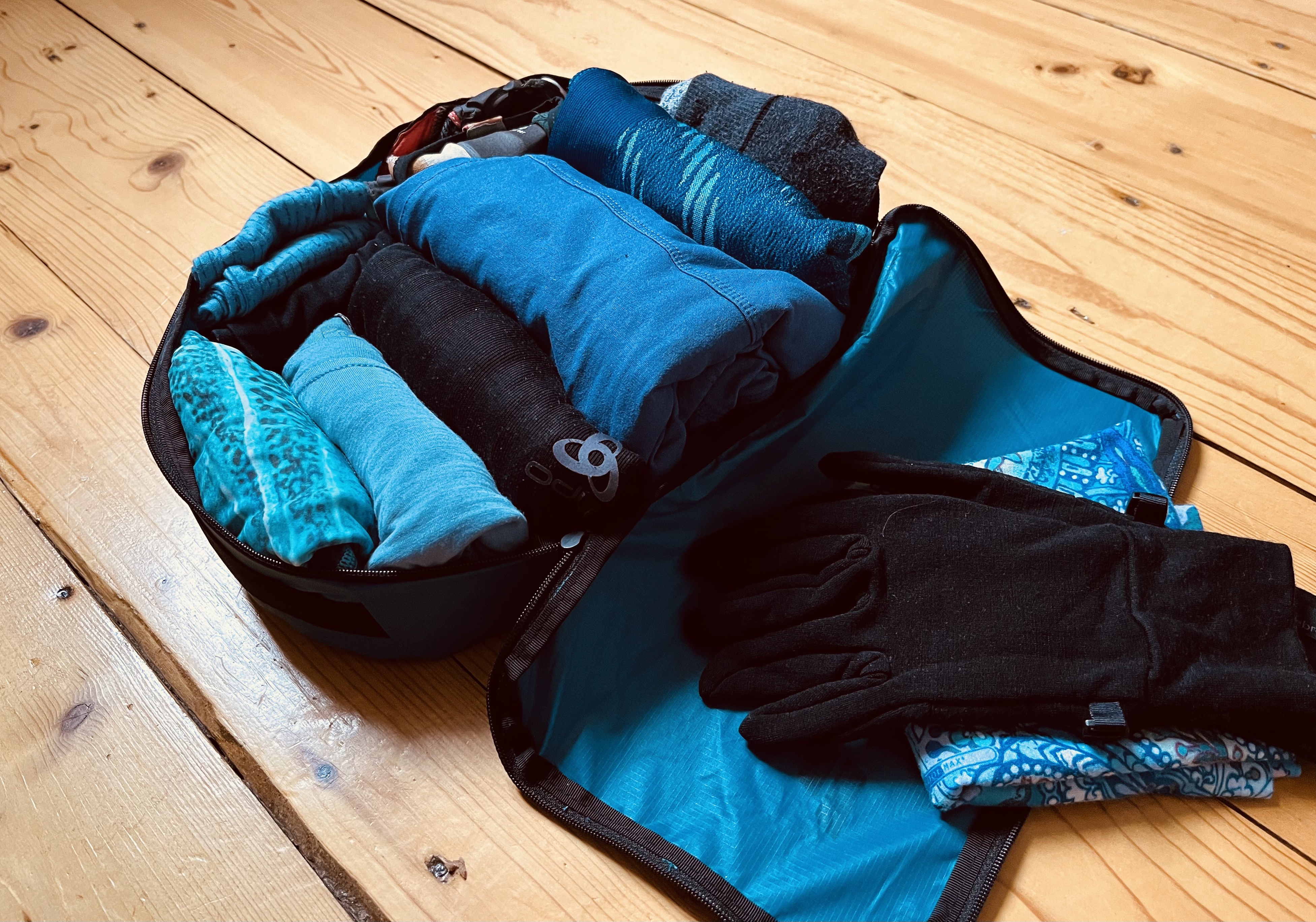
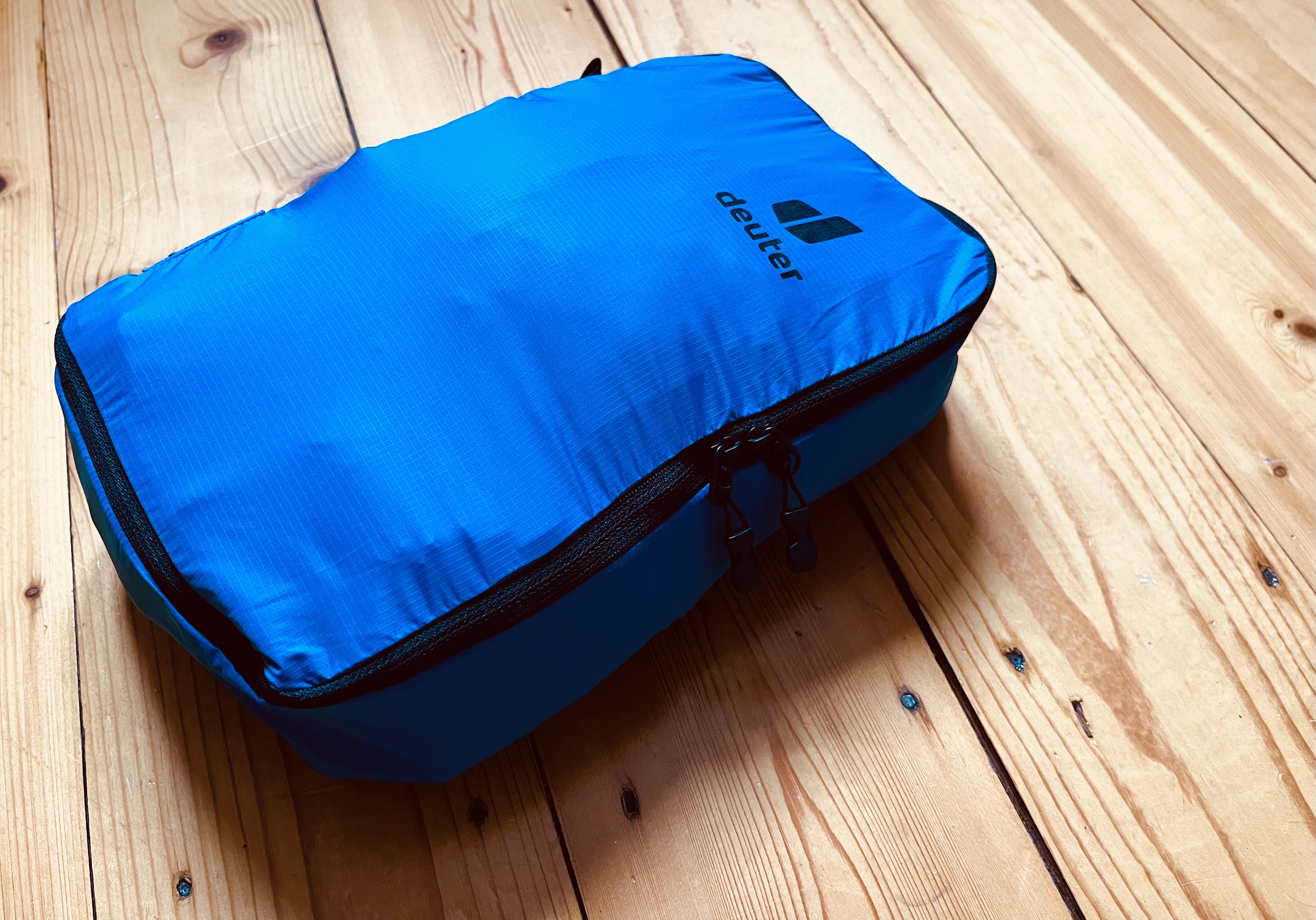
Some Optional Items
Additional shoes
This is a very tricky one, I think. I kind of wanted to take an extra pair of lightweight tracking shoes, which I could wear in the evenings but also use as a backup pair for the trail. So I opted for a pair of On Running shoes - the Cloud 5. However, I wasn’t happy with them at all. I wore them every night, but they were quite uncomfortable and cut into my heel, the last thing you want after 10 hours of hiking. Also, they added quite a bit of weight to my backpack. Now looking back, in the unlikely emergency of my primary hiking boots breaking beyond repair, I could have just gone to a store in one of the larger villages (especially in Austria there were plenty). That’s obviously not the case for every trail, so you should definitely take that into consideration.
If I’d hike the Alpe Adria Trail again, I would just take my Vibram 1/4 instead of an additional pair of trekking shoes. They are extremely light-weight, fold-up very small, and are the perfect evening wear for indoors and outdoors.
Swimwear
I took a swimsuit for the Alpe Adria Trail, but honestly, I don‘t think it‘s needed. There are a few opportunities to take a swim along the hike, but they are mostly „in the wild“, so a sports bra and panties or a pair of shorts will do just fine. It also means you only need to change once after the swim rather than before and after.
Hiking shorts
You could pack a pair of shorts for the evenings. Some people like to wear them during the day, too, but if you do so on the wrong stage, your legs will be completely scratched. I never wore shorts on the trail, but did find them a nice-to-have on hot evenings to do my yoga routine or sit outside. However, I don‘t think they‘re a must-have and I probably wouldn’t pack them next time.
What Else to Pack When Hiking a Long Distance Trail?
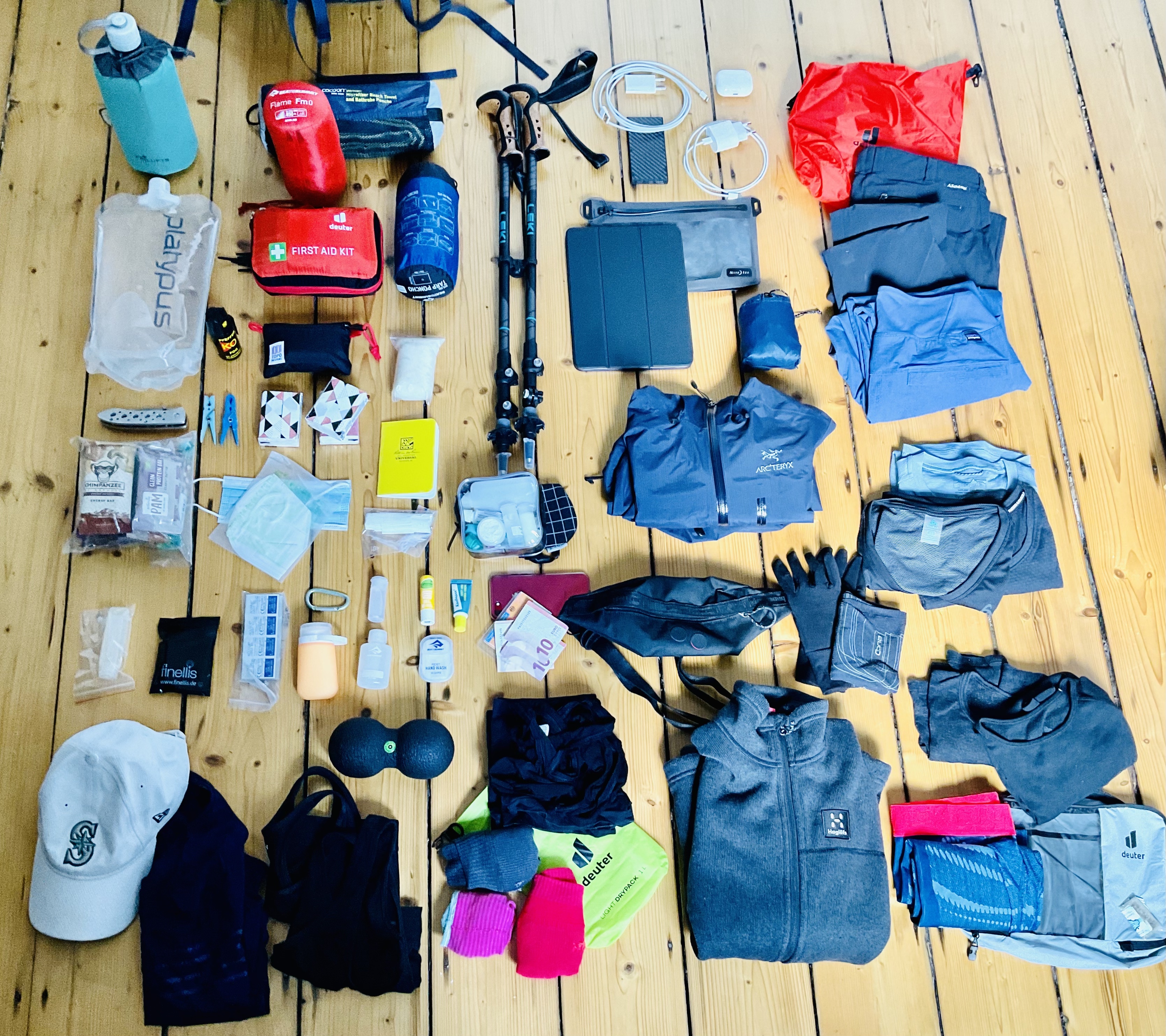
Packing the right clothing for a long-distance trail like the Alpe Adria Trail is a tricky business. But there’s more to consider, like a well-stocked first aid kit. I’ve written detailed guides for the entire equipment I took with me when hiking the Alpe Adria trail in spring 2022. You can find the entire packing list here or jump directly to the specific categories via the below links:
- Toiletries to take on a thru-hike
- Food and drink equipment for a long-distance trail
- The most important gear for a long-distance hike
- A well-stocked, high-quality first aid kit on your thru-hike
I hope this is helpful for you in planning your own hiking adventure in nature! If you want to get right into planning your own trip, just check out my 2-week itinerary for the Alpe Adria trail.

